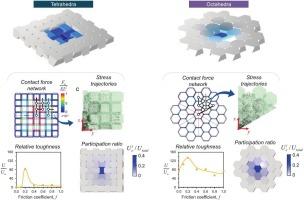Strength, stability, and interlocking efficacy in topologically interlocked materials based on tetrahedra and octahedra
IF 3.8
3区 工程技术
Q1 MECHANICS
International Journal of Solids and Structures
Pub Date : 2025-07-17
DOI:10.1016/j.ijsolstr.2025.113575
引用次数: 0
Abstract
Topologically Interlocked Materials (TIMs) are segmented systems composed of stiff blocks that interact through sliding, rotation, and jamming at contact interfaces. While TIMs improve toughness, this often comes at the expense of strength. Although recent experiments demonstrate the potential to overcome this trade-off, clear guidelines for achieving stiffness and strength in TIMs are still needed. In this study, we study the mechanical response of tetrahedral and octahedral TIM panels under out-of-plane loading using finite element models (FEM). We introduced two kinematic descriptors: Collective slippage and collective rotation, both of which capture inter-block deformation and show strong dependence on interfacial friction. To quantify the interlocking efficacy, we propose a new metric called the participation ratio, which is based on the strain energy distribution across blocks. This ratio was found to be 1.5 times higher in octahedral TIMs than in tetrahedral ones, indicating more effective load sharing among blocks. Contact force maps and stress trajectories revealed that the octahedral TIMs had a more interconnected force network, whereas the tetrahedra showed directional load channels. A key difference lies in the static stability: Octahedra can maintain equilibrium even in the absence of friction and thus are intrinsically stable TIMs, whereas tetrahedra require friction to achieve static equilibrium. We also proposed a strength-to-tensile stress ratio to capture the mechanical potential of TIMs independent of the base material properties, in which octahedra outperformed tetrahedra by 5.6 times. Overall, the greater number of contact surfaces and hexagonal base tessellation of octahedral TIMs confer superior interlocking efficacy, leading to enhanced stiffness, strength, and toughness.

基于四面体和八面体的拓扑互锁材料的强度、稳定性和互锁效果
拓扑互锁材料(TIMs)是由刚性块组成的分段系统,在接触界面上通过滑动、旋转和阻塞相互作用。虽然TIMs提高了韧性,但这通常是以牺牲强度为代价的。尽管最近的实验证明了克服这种权衡的潜力,但仍然需要明确的指导方针来实现TIMs的刚度和强度。在本研究中,我们采用有限元模型(FEM)研究了四面体和八面体TIM板在面外荷载下的力学响应。我们引入了两个运动学描述符:集体滑移和集体旋转,这两个描述符都捕获了块间变形,并显示出对界面摩擦的强烈依赖。为了量化联锁效果,我们提出了一个新的指标,即参与率,它基于块间的应变能分布。该比率在八面体TIMs中比在四面体TIMs中高1.5倍,表明块之间更有效地分担负载。接触力图和应力轨迹显示,八面体结构具有更相互连接的力网络,而四面体结构具有方向性载荷通道。一个关键的区别在于静稳定性:八面体即使在没有摩擦的情况下也能保持平衡,因此本质上是稳定的TIMs,而四面体需要摩擦才能达到静平衡。我们还提出了一个强度-拉伸应力比来捕捉与基材性能无关的TIMs的机械潜力,其中八面体的性能比四面体高5.6倍。总的来说,八面体tim的接触面数量和六边形基底镶嵌赋予了优异的联锁效果,从而增强了刚度、强度和韧性。
本文章由计算机程序翻译,如有差异,请以英文原文为准。
求助全文
约1分钟内获得全文
求助全文
来源期刊
CiteScore
6.70
自引率
8.30%
发文量
405
审稿时长
70 days
期刊介绍:
The International Journal of Solids and Structures has as its objective the publication and dissemination of original research in Mechanics of Solids and Structures as a field of Applied Science and Engineering. It fosters thus the exchange of ideas among workers in different parts of the world and also among workers who emphasize different aspects of the foundations and applications of the field.
Standing as it does at the cross-roads of Materials Science, Life Sciences, Mathematics, Physics and Engineering Design, the Mechanics of Solids and Structures is experiencing considerable growth as a result of recent technological advances. The Journal, by providing an international medium of communication, is encouraging this growth and is encompassing all aspects of the field from the more classical problems of structural analysis to mechanics of solids continually interacting with other media and including fracture, flow, wave propagation, heat transfer, thermal effects in solids, optimum design methods, model analysis, structural topology and numerical techniques. Interest extends to both inorganic and organic solids and structures.

 求助内容:
求助内容: 应助结果提醒方式:
应助结果提醒方式:


